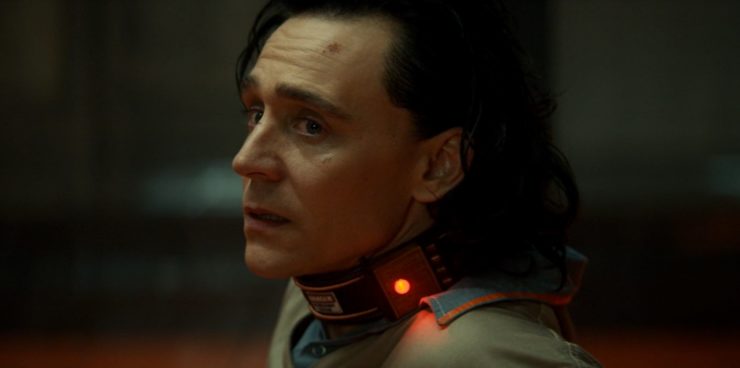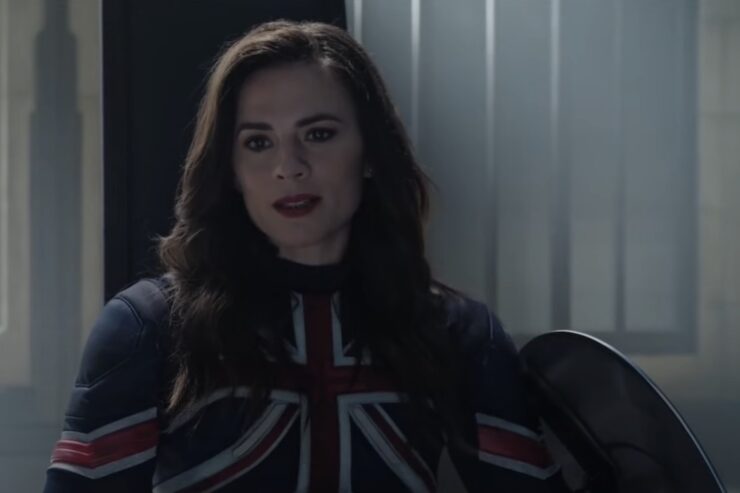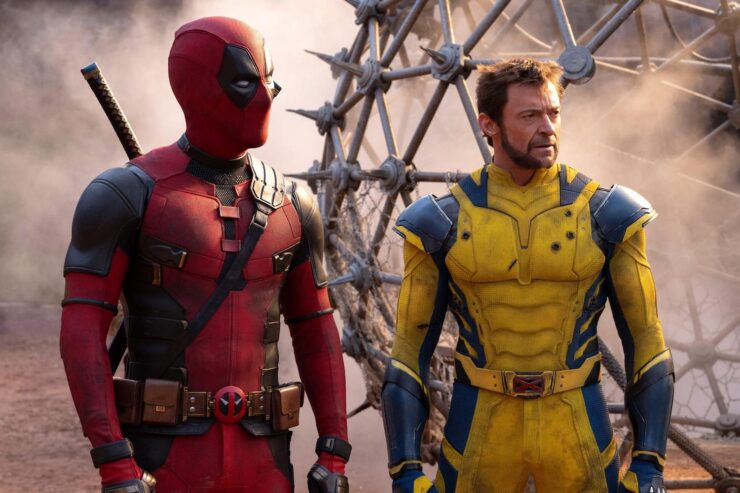On July 2, 2021, something gloriously purposeful occurred: fans expressed their fervent and untempered admiration for Loki.
Or at least, certain demographics did. “GOD BLESS FEMALE DIRECTORS” stated a now-viral tweet, accompanied by an image of the eponymous character from the Loki series. Kneeling, wearing a collar, and with his hands folded in his lap, Loki appeared to be gazing upward in submission. At my last glance, the post had over 59,000 likes. Multiple commenters referred to the “female gaze” evident in the shot; others referenced sexuality, the specific pose, and a newly “awakened” desire for something different.
Along with a swell of interest from women came an outpouring of excitement from queer viewers of all genders. Some fans discussed the appeal of Loki to asexual viewers. One fan wrote: “I’m bisexual and it is definitely the part of me that likes girls that is into this.” Another jokingly captured the queerness of the comments section by remarking about the director: “Didn’t she get the memo about no kink at pride?”
The elision of the female gaze, the power-dynamic visual, and the perceived queerness of the image is perhaps not surprising. Ever since his original depiction in Norse mythology, the character of Loki has played a symbolic role as an “othered” figure, with queer and feminine-associated aspects that contrast with the socially acceptable norm. Simultaneously, Loki has been interpreted by some as a genderfluid and boundary-crossing figure, resisting social and sexual categorization. Links between Loki’s depiction in the myths and in the Marvel films provide clues as to why the MCU’s Loki shines as a beacon for underrepresented female and queer desires–desires which have been hard to miss ever since fan reactions to the first Thor movie broke out. As one commenter put it in the recent discussion: “They know why we are here.”
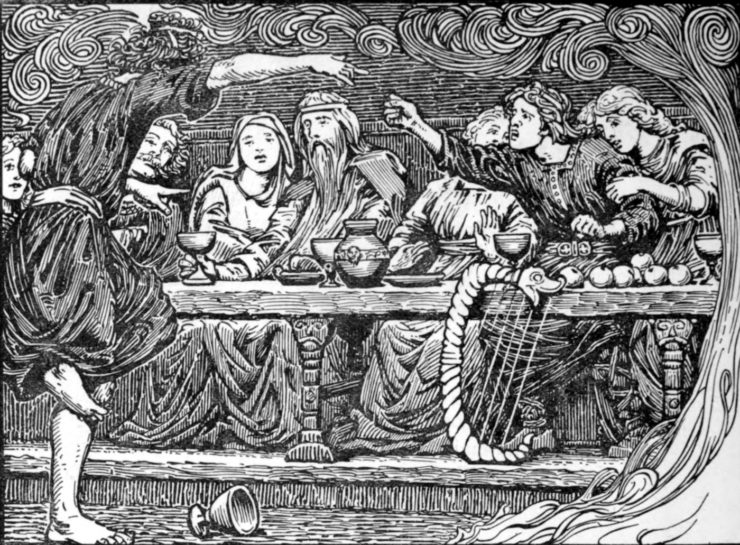
Introducing Loki in his edition of the Norse Myths, Kevin Crossley-Holland notes the trickster’s hybridity, claiming that Loki “embodies the ambiguous and darkening relationship between the gods and the giants.” (xxix) As the stories unfurl, Loki emerges as the social other to the community of immortals. One myth describes him being excluded from the community after losing a bet. “Loki ran out of Gladsheim. For some time the Schemer stood listening to the hum inside the hall – the hive of happiness. He began to dream of revenge, and slowly his lips curled into a twisted smile,” Crossley-Holland writes. (53)
In this scene, Loki’s “twisted” smile serves as a visual marker of his difference, or, as queer readers might understand it, a symbolic difference from the “straight” norm. Striking descriptions throughout the tales illustrate Loki’s physical alterity: his eyes gleam different colours, including brown, green and indigo (80), and his “scarred” lips twist into a “wolfish” smile. (80) The scarring also serves as a reminder of Asgard’s desire to silence its mischievous, chaotic other. Previously, Loki’s lips had been sewn up as punishment when one of his tricks went awry (53), leaving him with marks long after the stitching had been unpicked. The hint of the bestial in the description is no coincidence, either, since Loki can transform into animals, often taking the form of a slighted animal such as a flea or fly.
Significantly, the myths also refer to Loki’s transformations into women and show the derision that the other gods direct at Loki for inhabiting, enjoying, and making use of a female body. Odin mocks Loki for having “lived under the earth for eight winters in the shape of a woman, a milkmaid” and borne children. (164) These bestial and feminine “others” come together in a now-infamous story of Loki transforming into a mare, mating with a stallion, and giving birth to the magical horse Sleipnir. Despite the attacks on his masculinity, Loki appears to enjoy shape-shifting and gender-shifting, even in front of the collective of immortals. When Thor is required to dress as a bride on a secret mission, the Thunder God worries that he will look “unmanly,” yet Loki enthusiastically volunteers to dress up as his “maidservant.” (72) The contrast in Thor and Loki’s attitudes to cross-dressing remind us that Loki’s attitude to gender deviates from the normative group.
It is telling that the other gods insult Loki by calling him “womanish.” (165) His shape-shifting can be read an extension of the alternative masculinity that shapes his powers and skills: by changing into women, animals and other creatures, he avoids the need for physical altercations. While most versions of the myths use “he/him” pronouns for Loki, modern queer readers might refer to his character as genderfluid or non-binary. Loki’s positioning as an ambiguous, border-crossing figure means that both interpretations (and more) are likely to continue–few other characters encompass the breadth of marginalized identity so well as a body-hopping trickster who appears both male and female, human and monstrous, silenced and outspoken.
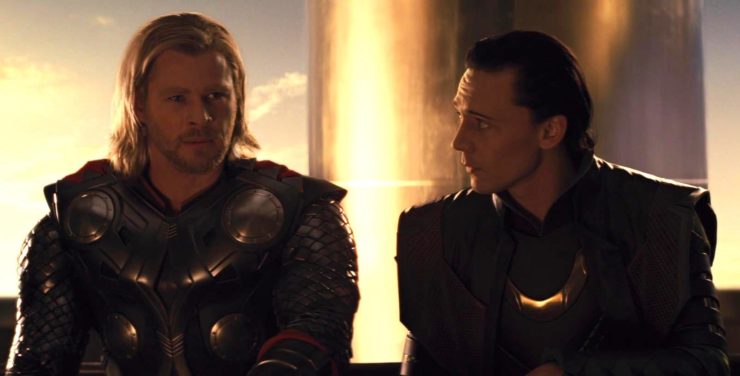
In the MCU, Loki’s physical alterity and gender-fluidity similarly mark him out as different from the collective of superheroes. Marvel’s Thor and Loki form a binary where Thor is the hyper-masculine standard and Loki the representative of all that is othered: the feminine, the genderfluid, the atypical male, the queer. Given the importance of costumes and appearances in superhero movies and the long tradition of muscular male bodies in the genre, the visual contrast between Thor and Loki holds symbolic power.
My first thought upon glimpsing the MCU’s Loki was of the character Cassius from Shakespeare’s Julius Caesar. In that play, the titular Julius Caesar states: “Yond Cassius has a lean and hungry look, / He thinks too much. Such men are dangerous.” (1.2.194-195) Caesar’s remark suggests that Cassius’ slight build indicates intellectualism and, by implication, artfulness and dishonesty. I wasn’t the only one who thought that Caesar’s famous words could be a perfect description of Loki–Kenneth Branagh, the director of Thor and Thor: The Dark World, had requested that Loki have a “lean and hungry look, like Cassius in Julius Caesar.” As a leading Shakespearean, Branagh would have been well aware of the connotations.
Buy the Book
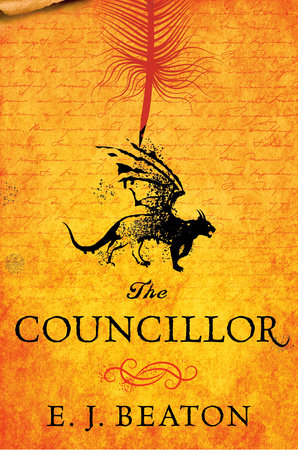

The Councillor
Just as the slender Cassius contrasts with the sporting Marc Antony in Julius Caesar, the MCU’s Loki stands out in contrast to Thor. Thor appears a model of strength-based masculinity, his bulging muscles indicating physical power and his tan demonstrating that he spends time outdoors. Loki, on the other hand, has the pasty look of someone who spends time inside, studying or perhaps scheming. The contrast between Thor and Loki also taps into the American perception of English and European men as more feminine–Loki’s English accent and light voice in the Marvel films demarcate him from Thor, who maintains a difficult-to-place international accent and deep voice. Moreover, when he appears on Earth, Loki dresses in a European style of fashion, looking at ease in an elegant coat and scarf at an art gala, or garbed in a sleek black suit opposite Thor’s jeans and denim jacket. The link between Loki’s clothing and his feminine othering is made explicit in Thor: Ragnarok when Thor responds to Loki’s protest that he’s not a “witch” with the witticism: “No? Then why are you dressed like one?”
Though it may be a jest, Thor’s question touches upon the subversive power of Loki’s visuals. Loki’s dress style reflects his female-associated weapons and fighting tactics–defying male stereotypes and using powerful magic, he threatens traditional masculinity just as witches do. Thor may wield a hammer to batter his foes, in one of the most obvious uses of a phallic symbol in modern cinema, but Loki employs rhetoric, cunning, and magic rather than brute force. His illusions and persuasive language represent alternatives to physical strength. When Loki does take up a physical weapon, it is a weapon associated with subtlety and deception: his proficient dagger-wielding contrasts with Thor’s hammer-swinging, requiring more precision than power.
It is fitting, then, that Loki’s magic stems from his mother. In a deleted scene from Thor: The Dark World, Frigga informs Thor that she does not regret passing on her magic to Loki, confirming the link. She is also shown wielding daggers and using similar fight moves to Loki. Drawing the parallel further, Malekith refers to Frigga as a “witch” before having her murdered. Whilst Loki derives his powers from Frigga, Thor is often given the second name “Odinson,” reminding viewers of the link between Thor and his father–this contrast further sharpens the feminine/masculine juxtaposition of Loki and Thor.
While Thor’s skills and powerful build are associated with superheroes who save the day, Loki’s visuals and talents suggest a “dangerous” man like Cassius. The binary constructed thus idealizes a corporeally-oriented, anti-intellectual, socially acceptable masculinity, and villainizes all that is excluded from this male stereotype. And yet, dating back from MCU Loki’s very first appearance in Thor, the fan reaction suggests that many viewers relish the subaltern figure of Loki in all his fluid, chaotic, queer glory. Tom Hiddleston’s now-famous appearance as Loki at San Diego Comic-Con in 2013 demonstrated the extent of his character’s popularity, with the crowd screaming at his every word and falling silent on his command, and the video racking up millions of views. Rolling Stone began their review of Thor: The Dark World with the succinct sentence: “Not enough Loki.” Some fans created memes that humorously noted the popularity of both actor and character; others celebrated the character of Loki by modelling his border-crossing and gender subversion through gender-bent cosplay.
The overwhelming popularity of Loki suggests a hunger amongst fans for marginalized figures on screen. Fans chose Loki, even when the films did not. And so, in 2021, we arrived at the Loki TV series, where at last the trickster occupies the central role. Could this be a chance for female and queer fans to see Loki’s identity explored in depth, and perhaps even a chance to celebrate that complex selfhood?
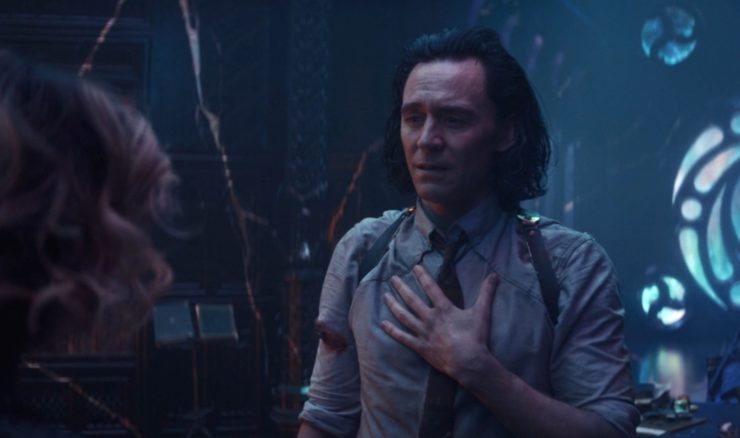
With Loki taking precedence at last, expectations were running high. Across its six episodes, the Loki series has delivered satisfying moments for those who wished to see Loki through the female gaze and with props that suggest a power dynamic. “No thoughts just Loki in a collar” one user posted on Twitter, with four images of Loki in his collar from the TV series, quickly racking up over 1300 likes. The explosion of excitement over Loki’s kneeling scene in episode four indicates the extent of the hunger for a female directorial gaze with Loki as submissive subject.
Not only that, but Loki has provided fans with the long hoped for coming-out of the titular character. Loki’s declaration that he has experienced attraction to both princes and princesses–“a bit of both”–validated the popular readings of his character as bisexual or pansexual and made fans feel seen. “The moment I heard that line that confirmed it all, my heart absolutely soared,” one commenter wrote on a YouTube video about Loki’s sexuality. “FINALLY A MARVEL CHARACTER THAT REPRESENTS ME,” another added. For fans seeking more examples of gender-shifting and shape-shifting, Loki also delivered, with a variant of Loki possessing a range of bodies in episode two and eventually revealing herself to be Sylvie, a female version of Loki. A direct reference to Loki’s gender-fluidity even snuck into the first episode: on the case file that Mobius handles, Loki’s “sex” is marked as “fluid.”
Yet despite offering more representation, the series appears to lack curiosity about the embodied experiences of gender-fluid, bisexual, and pansexual people. How does it feel to be genderfluid, and does Loki see himself that way? How does it feel to be attracted to more than one gender? What does Loki’s sexuality mean to him (and his “variants”)–is it a source of joy, a source of stress, a significant part of his life? These questions seem to be absent from the Loki series, with Loki’s occupation of other bodies used purely to further the plot, and his sexuality only acknowledged with the single coming-out line. Perhaps a story that explored these facets of Loki’s identity would devote more screentime to the experience of queerness, genderfluidity, or even atypical masculinity. Loki’s character speaks to many of us because he is othered, but I can’t help wondering: what would a series that centered Loki look like?
Undoubtedly, the Loki series has centered Loki in the plot, but opinions vary as to whether it has centred his characteristics. Enmeshed in the MCU’s worldbuilding, Loki often seems more concerned with the Time Variance Authority and its plot implications than it does with Loki himself, and fans who expected a series where Loki exuded his mischievous, playful, chaotic, queer, and fluid nature may well wonder why it is so constrained here. The color scheme of the TVA emblematizes the shift in Loki’s characterization: it is drab, and Loki’s personality seems to have taken on a bit of that drabness. His usual color and vibrancy seem better represented by the rainbow Bifröst and the dramatic costumes of Asgard than by a prison jumpsuit or a plain shirt. We are far from the Loki whom Thor described as a “witch,” here. Indeed, these new outfits seem to match the narrative restrictions imposed upon Loki in the series–as the jumpsuit suggests, he is imprisoned by the TVA for several episodes, not only literally but in story terms, unable to truly shine. As the plain shirt and tie suggest, he plays a more subdued part throughout much of the series, lacking the sparkle of the Loki who charmed the Grandmaster in Thor: Ragnarok or manipulated Thor with subtle rhetoric in Thor. Often, Loki’s non-conforming role seems to have been transferred to other characters (and variants) in the Loki series.
This is not to suggest that Loki is devoid of scenes featuring the trickster’s queerness or feminine-associated characteristics. The “female gaze” and suggestive poses are hard to miss, as fans joyfully noted. The series also provides flashes of Loki’s non-brawn-oriented fighting skills, such as when Loki fights Sylvie in a sexually charged flurry of leaping, tumbling, dagger-wielding, and magic. On top of this, Loki’s coming-out line is delivered in a gloriously casual tone, asking fans to accept his sexuality just as easily and naturally as Sylvie does. This coming-out episode is given a triumphant flourish by the cinematography. When Loki discusses his sexuality with Sylvie on Lamentis-1, the color scheme seems to hint at his sexuality: pink, purple, and blue light pervades the moon throughout the episode, in a visual style noted as “bisexual lighting,” reflecting the colors of the bisexual flag. Even inside the buildings, the same lighting emphasizes Loki’s queerness. The correspondence between the color scheme and Loki’s coming-out in the same episode makes this a particularly strong queer visual. Clearly, the series celebrates Loki’s marginalized identity at times and offers moments of the Loki we know and love. Yet for much of its screentime, Loki’s pulsing energy seems curiously repressed.
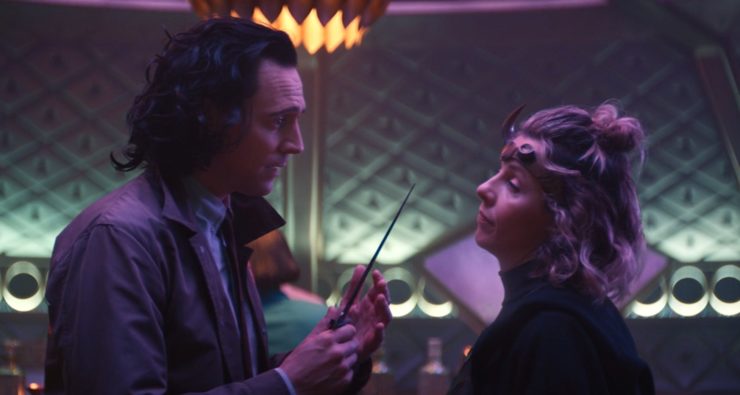
Aside from returning Loki to his chaotic and colorful self, how could a TV series devote more time to experiential side of his gender-fluidity and shape-shifting? When Sylvie possessed the bodies of several people in episode two, the opportunity to explore the feeling and significance of these experiences seemed to dangle there, almost tangible on-screen. Does Loki feel a sense of ease, assimilating the embodied experience of others, merging and flowing effortlessly? Is there some processing, whereby he must adapt to the feeling of a different body? Is there a jarring effect when he inhabits the body of someone with vastly different social circumstances and hurdles to his own? And how does Loki’s body-jumping affect his emotional state, both in the short term and in the long term? These same questions could equally be explored for Sylvie, assuming that we consider her as a distinct character from Loki.
As for an expanded depiction of Loki’s sexual preferences, both possibilities and challenges lurk in the offing. On one hand, the idea that bisexual and pansexual people must quantify their sexuality on the screen or page with a perfectly even representation of relationships across genders is harmful, and fails to match the variety of real-life experiences. Loki and Sylvie’s interest in each other already provides a form of queer representation, featuring a relationship of sorts between male-presenting queer character and a female-presenting queer character, an important piece of the mosaic of bi/pan experiences. The expectation that bisexual people must perform queerness to some externally imposed standard does harm to a community that already faces challenges with visibility, mental health, and acceptance.
On the other hand, there are a myriad of ways that Loki’s sexuality could be worked into the series, regardless of whether he is attracted to Sylvie or to other characters. Does he approach women with a queer sensibility–with a sense that the male body is penetrable and traditional gender roles may be subverted? What does his sexuality mean to him? Does he take on a particular aesthetic that maps to a specific part of queer culture, or is he abstracted from real-world queer communities? What about attitudes to queerness in Asgard? As a character who loves to play and shift, does he enjoy switching roles in the sexual and romantic arenas, and does his approach to a potential partner vary depending on their gender? All of these questions and more could inform an interesting portrayal of a bisexual or pansexual character, regardless of the genders of Loki’s potential love interests.
It is possible that the next series of Loki will herald the return of a more colorful, dynamic Loki, and even add to the depiction of Loki’s queerness. If so, it would represent a change from season one, where fans have gained only glimpses of the vibrant and dynamic “other” of Asgard. Perhaps a series two will show us a Loki whose othered identity is now embraced: a Loki refulgent in his queerness and alternative masculinity: the character so beloved of queer and female viewers. Perhaps it will even expand upon Loki’s identity.
Until then, the outpouring of fan desire for Loki reminds us that viewers longing for a female gaze, a queer gaze, a representation of marginalized identity, or a different masculinity on-screen are not alone. Our perspectives and interests may be underrepresented in mainstream superhero franchises, but they are shared with a community of fellow viewers. “I THOUGHT I WAS THE ONLY ONE,” one commenter declared, in regards to the viral celebration of Loki kneeling. On another post showing the same picture of Loki, another person chimed in with the exact same phrase: “I THOUGHT I WAS THE ONLY ONE.” The fan reaction to Loki may be ravenous, but it is far from frivolous. It reminds female and queer fans that we are not alone in feeling as we do, and in admiring a character who represents an alternative to the hyper-masculine, heteronormative standard. Our tweets are imbued with glorious purpose.
Marginalized fans have often had to imagine their desired representation and seek out possibilities for alternative readings, looking for a porous element to the text through which they may engage. In this respect, the adaptation of Loki to screen, while constrained in some respects, elicits the same kind of reaction as Loki in the myths does. Crossley-Holland calls Loki “the most fascinating character in the entire anthology” and adds: “Without the exciting, unstable, flawed figure of Loki, there could be no change in the fixed order of things, no quickening pulse” (xxix). Alterity remains a constant force across the Norse myths and the Marvel films, and its potency could very well challenge the order and stability of things–not only branching the timeline, but shattering expectations around gender, sexuality, and the male gaze.
***
Author’s notes:
- This article uses “he/him” pronouns for Loki in line with the usage of pronouns in both the MCU and in the edition of the Norse myths cited here. This usage is not intended as a comment on Loki’s gender identity, which is discussed here in broader terms.
- This article refers to one edition of the Norse myths for the purpose of focus and close reading. A comparative analysis of the representation of Loki across multiple editions is beyond the scope of this piece, but would open up further avenues of discussion.
Key texts cited:
- Kevin Crossley-Holland, The Penguin Book of Norse Myths, Penguin: London, 2011.
- Loki, Series 1, Disney+, 2021.
- Thor, Paramount Pictures, 2011.
- The Avengers, Walt Disney Studios, 2012.
- Thor: The Dark World, Walt Disney Studios, 2013.
- Thor: Ragnarok, Walt Disney Studios, 2017.
Other sources cited, in order of citation:
- Julius Caesar, William Shakespeare, first performed 1599; this edition: Yale University Press: New Haven, 2006.
- “‘Thor’ star Tom Hiddleston Getting Fit For Loki, Finds Similarities In Shakespearean Characters”, Josh Wigler, MTV.com, January 6, 2009.
- “Tom Hiddleston’s Appearance as Loki Drives Comic-Con Completely Insane”, Buzzfeed, July 21, 2013.
- “Thor: The Dark World – Movie Review”, Rolling Stone, November 7, 2013.
- Comments on YouTube video: “loki laufeyson • BI BI BI [happy pride month]”, uploaded June 26, 2021.
E. J. Beaton’s debut fantasy novel The Councillor was published by DAW Books in March 2021 and is set in a queernorm world with gender equality. She holds a PhD in English, with a research background in Renaissance literature, mythology, poetics, and fantasy. E. J. has presented on Loki and masculinity at the Australian Centre for the Moving Image, and has published a chapter on female Machiavellian characters in fantasy (Bloomsbury Academic, 2016). She is also a Pushcart nominated poet. Her interest in atypical antiheroes owes a little to reading about Loki at a very young age.










